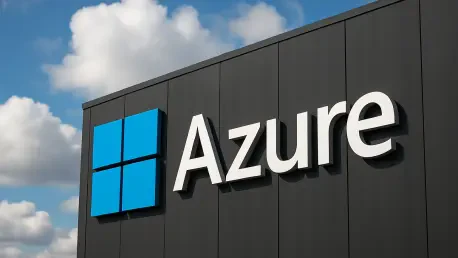In an era where artificial intelligence is reshaping industries at an unprecedented pace, the demand for robust computational infrastructure has never been more critical, especially as models grow exponentially in complexity and scale. Microsoft Azure has stepped up to this challenge with a groundbreaking advancement in cloud computing technology. This latest innovation promises to redefine the capabilities of AI supercomputing, offering a solution tailored for the most intensive workloads. By pushing the boundaries of hardware and networking, Azure is positioning itself at the forefront of the AI revolution, catering to enterprises and research institutions alike. This development not only addresses current needs but also sets a new benchmark for what is possible in the realm of frontier AI applications, sparking curiosity about how such power will transform real-world outcomes.
Pioneering AI Infrastructure
Cutting-Edge Hardware Integration
The cornerstone of Azure’s latest offering lies in its integration of state-of-the-art hardware designed specifically for high-demand AI tasks. The NDv6 GB300 VM series is powered by the NVIDIA GB300 NVL72 platform, incorporating 72 Blackwell Ultra GPUs and 36 Grace CPUs per rack. This setup delivers a staggering 37 terabytes of memory alongside 1.44 exaflops of FP4 Tensor Core performance, making it uniquely suited for large-scale AI models and generative tasks. Additionally, the system employs NVIDIA’s next-generation InfiniBand networking, ensuring seamless interconnectivity across clusters. Within each rack, fifth-generation NVIDIA NVLink Switches provide an impressive 130 terabytes per second of bandwidth between GPUs, creating a unified memory space that enhances computational efficiency. This configuration represents a significant leap forward in addressing the computational bottlenecks often encountered in advanced AI workloads, setting a new standard for performance.
Advanced Networking Capabilities
Beyond raw hardware power, the networking architecture of this new VM series is equally transformative, facilitating efficient communication across expansive systems. For cross-rack interactions, the NVIDIA Quantum-X800 InfiniBand platform offers 800 gigabits per second of bandwidth per GPU, bolstered by adaptive routing and telemetry-based congestion management. This is further enhanced by NVIDIA’s Scalable Hierarchical Aggregation and Reduction Protocol (SHARP) v4, which optimizes distributed operations for maximum throughput. Such advancements ensure that even as data demands grow, the system remains responsive and reliable under pressure. The focus on networking underscores a critical understanding that AI supercomputing is not just about processing power but also about how effectively components communicate. This holistic approach to infrastructure design is poised to support the next wave of AI innovations, enabling smoother handling of complex inference and reasoning tasks.
Performance and Industry Impact
Benchmarking Excellence
A deeper look into the performance metrics of the NDv6 GB300 VM series reveals its dominance in industry-standard evaluations. According to NVIDIA, the Blackwell Ultra GPUs achieve up to five times higher throughput per GPU on the 671-billion-parameter DeepSeek-R1 model compared to the previous Hopper generation, as evidenced by MLPerf Inference v5.1 benchmarks. Furthermore, the GB300 NVL72 system demonstrates exceptional results in newer tests like Llama 3.1 405B, highlighting its superiority over earlier architectures. These figures are not just numbers; they represent a tangible advancement in the ability to process massive AI models with speed and accuracy. The collaboration between Azure and NVIDIA has clearly paid off, optimizing every layer of the modern AI data center to deliver infrastructure at an unprecedented scale. Such performance metrics signal a readiness to tackle the most challenging AI applications currently in development.
Adapting Data Center Dynamics
Implementing this high-performance cluster demanded significant adaptations across Azure’s data center stack to ensure reliability under intense workloads. Innovations in liquid cooling solutions, power distribution systems, and orchestration software were essential to support the high-density environment created by the NDv6 GB300 VMs. These modifications address the unique challenges posed by cutting-edge technology, ensuring that thermal management and energy efficiency keep pace with computational demands. The scale of over 4,600 NVIDIA GB300 NVL72 systems in the first large-scale production cluster of its kind required meticulous planning and execution. This effort reflects a broader industry trend toward infrastructure that can sustain the rapid growth of AI applications. By tackling these operational hurdles, Azure has demonstrated a commitment to not only meeting current needs but also anticipating future challenges in AI-driven computing environments.
Shaping the Future of AI Innovation
Reflecting on this milestone, it’s evident that Azure’s deployment of over 4,600 systems marked a pivotal moment in the evolution of AI infrastructure. The strategic partnership with NVIDIA, culminating in exceptional benchmark results, showcased what collaborative innovation could achieve in the past. Looking ahead, the focus should shift to how such powerful tools can be leveraged to drive transformative outcomes across industries. Enterprises and research bodies are encouraged to explore the potential of this infrastructure for accelerating AI model development and deployment. Consideration of scalable solutions that adapt to evolving needs will be crucial, as will investment in skills to maximize these advanced systems. The groundwork laid by this initiative offers a blueprint for future advancements, urging stakeholders to build on this momentum to address emerging challenges in AI and supercomputing with creativity and foresight.









